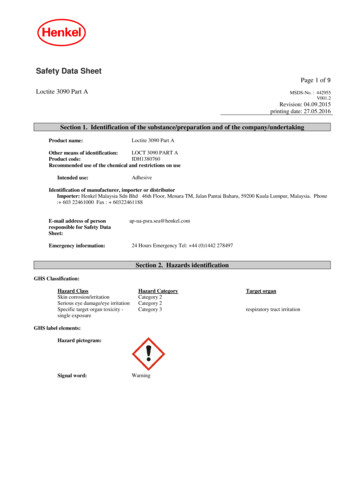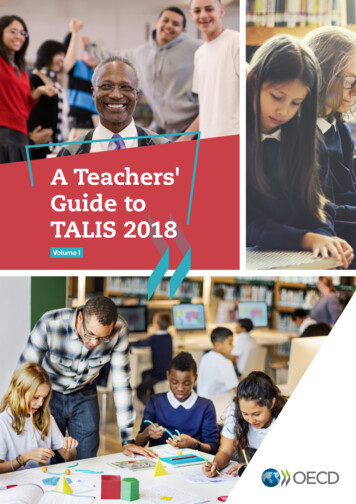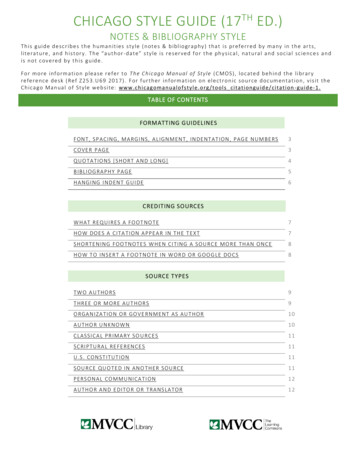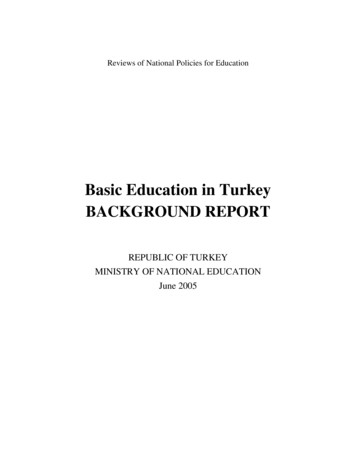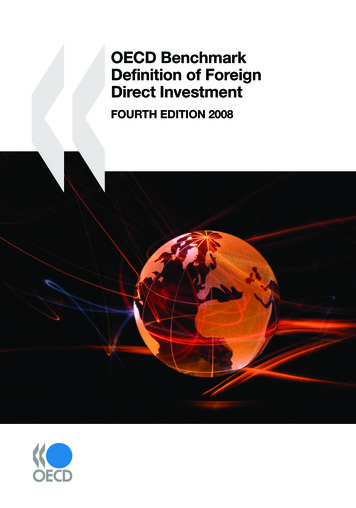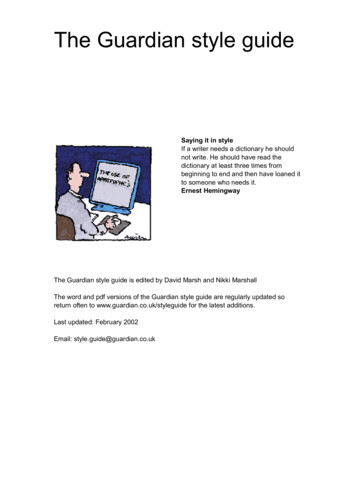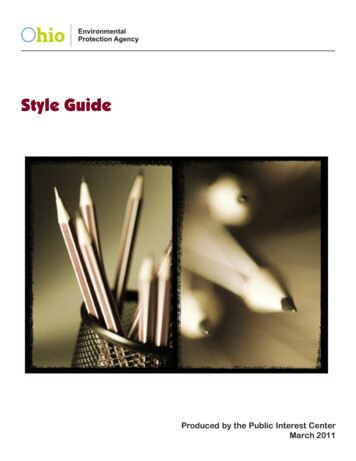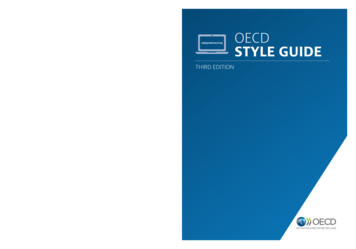
Transcription
styleguide@oecd.orgOECDSTYLE GUIDETHIRD EDITIONstyleguide@oecd.org022015011cov.indd 1OECD Style Guide – Third EditionQUESTIONS?17-Sep-2015 3:18:59 PM
styleguide@oecd.orgOECDstyle Guidethird edition
See the OECD editorial guidelines at: http://oe.cd/pubguidelines. For legalmatters, consult http://oecdshare.oecd.org/SGE/SITES/LEGALINFO or contactLEGER@oecd.org.Please continue to send comments or queries to styleguide@oecd.org, or bedirectly in touch with your PAC editors. Refer also to the OECD’s CollaborativeKnowledge-based Terminology Portal (otherwise known as AGORA, www.oecdagora.org) which aims to provide correct, consistent definitions and translationsof economic and other specialist terms.We would like to thank all the colleagues who have contributed to this revision,including the many communications co-ordinators, publications assistants andwriters who have regularly sent us helpful comments and questions.oecd style guide - third edition @oecd 2015
forewordForewordToday, the way we read and write has changed with the availability of onlineand mobile resources 24 hours a day, 7 days a week. We have all come to expectinformation that is accessible: easy to find, understand and use or re-use.This third edition of the OECD Style Guide is designed to help you draft andorganise your published material so that readers can easily navigate, understandand access OECD analysis, statistics and information. It does so by: providing basic guidelines to ensure that we present our work in a waythat meets the needs of our expanding, mostly online, audiences offering tips on good writing setting out the standards and conventions that should be used for draftingall OECD information.The rules and conventions are for use by OECD staff working on all OECDcommunications platforms, whether print or on line, books, articles, webpages,working papers, social media or presentations. They are designed to encourageconsistency and clarity. Conventions that are appropriate for one platform andnot others have been highlighted.We recommend consulting the most recent editions of the Concise OxfordEnglish Dictionary and the Oxford Style Manual for details not covered here.Please also refer to the PAC Publishing Guidelines available on http://oe.cd/pubguidelines.oecd style guide - third edition @oecd 20153
table of contentsTable of contentspart i1.Publishing at the OECD . . . . . . . . . . . . . . . . . . . . . . . . . . . . . . . . . .1010Who are our readers? . . . . . . . . . . . . . . . . . . . . . . . . . . . . . . . . . . . . . . . . . . . .Why do we publish? . . . . . . . . . . . . . . . . . . . . . . . . . . . . . . . . . . . . . . . . . . . . .11What do we publish? . . . . . . . . . . . . . . . . . . . . . . . . . . . . . . . . . . . . . . . . . . . .12How do we publish? . . . . . . . . . . . . . . . . . . . . . . . . . . . . . . . . . . . . . . . . . . . . .14How do people read? . . . . . . . . . . . . . . . . . . . . . . . . . . . . . . . . . . . . . . . . . . . .16Writing for the OECD . . . . . . . . . . . . . . . . . . . . . . . . . . . . . . . . . . . .182.Organising your content . . . . . . . . . . . . . . . . . . . . . . . . . . . . . . . . . . . . . . . . . .19Titles and headings . . . . . . . . . . . . . . . . . . . . . . . . . . . . . . . . . . . . . . . . . . . . . .22Structuring your publication . . . . . . . . . . . . . . . . . . . . . . . . . . . . . . . . . . . . . .2428Executive summaries . . . . . . . . . . . . . . . . . . . . . . . . . . . . . . . . . . . . . . . . . . . . .Chapter abstracts . . . . . . . . . . . . . . . . . . . . . . . . . . . . . . . . . . . . . . . . . . . . . . . .29Figure and table presentation . . . . . . . . . . . . . . . . . . . . . . . . . . . . . . . . . . . . .30Marketing blurbs . . . . . . . . . . . . . . . . . . . . . . . . . . . . . . . . . . . . . . . . . . . . . . . .31Watch out for plagiarism . . . . . . . . . . . . . . . . . . . . . . . . . . . . . . . . . . . . . . . . .32Drafting tips and principles of style . . . . . . . . . . . . . . . . . . . . . . .343.4publishing at the oecdKeep it short and simple . . . . . . . . . . . . . . . . . . . . . . . . . . . . . . . . . . . . . . . . . .34Choose the right words . . . . . . . . . . . . . . . . . . . . . . . . . . . . . . . . . . . . . . . . . .38A few tips on grammar and syntax . . . . . . . . . . . . . . . . . . . . . . . . . . . . . . . .47Drafting checklist . . . . . . . . . . . . . . . . . . . . . . . . . . . . . . . . . . . . . . . . . . . . . . . .49oecd style guide - third edition @oecd 2015
table of contentsPART II RULES AND CONVENTIONS4.Abbreviations and acronyms . . . . . . . . . . . . . . . . . . . . . . . . . . . . .52Other common abbreviations . . . . . . . . . . . . . . . . . . . . . . . . . . . . . . . . . . . . .53Units of measure . . . . . . . . . . . . . . . . . . . . . . . . . . . . . . . . . . . . . . . . . . . . . . . .54Abbreviations used in statistical tables . . . . . . . . . . . . . . . . . . . . . . . . . . . . .55Bibliographical referencing: Sources and citations . . . . . . . . . . . .565.Four golden rules . . . . . . . . . . . . . . . . . . . . . . . . . . . . . . . . . . . . . . . . . . . . . . . .56In-text citations . . . . . . . . . . . . . . . . . . . . . . . . . . . . . . . . . . . . . . . . . . . . . . . . .57General guidelines . . . . . . . . . . . . . . . . . . . . . . . . . . . . . . . . . . . . . . . . . . . . . . .57Citation of a complete work . . . . . . . . . . . . . . . . . . . . . . . . . . . . . . . . . . . . . .59Citation of part of a work . . . . . . . . . . . . . . . . . . . . . . . . . . . . . . . . . . . . . . . .59Citation of a dataset or table . . . . . . . . . . . . . . . . . . . . . . . . . . . . . . . . . . . . . .61Sources of figures, tables and boxes . . . . . . . . . . . . . . . . . . . . . . . . . . . . . . .61Citation of unpublished material . . . . . . . . . . . . . . . . . . . . . . . . . . . . . . . . . . .62References in a language other than English or French . . . . . . . . . . . . . . .63References for legal documentation . . . . . . . . . . . . . . . . . . . . . . . . . . . . . . . .63Internet references . . . . . . . . . . . . . . . . . . . . . . . . . . . . . . . . . . . . . . . . . . . . . .63Social media . . . . . . . . . . . . . . . . . . . . . . . . . . . . . . . . . . . . . . . . . . . . . . . . . . . .64Breaks and hard spaces . . . . . . . . . . . . . . . . . . . . . . . . . . . . . . . . .65Capitalisation . . . . . . . . . . . . . . . . . . . . . . . . . . . . . . . . . . . . . . . . .666.7.General guidelines . . . . . . . . . . . . . . . . . . . . . . . . . . . . . . . . . . . . . . . . . . . . . . .66Use of capitals . . . . . . . . . . . . . . . . . . . . . . . . . . . . . . . . . . . . . . . . . . . . . . . . . .66Use of lower-case letters . . . . . . . . . . . . . . . . . . . . . . . . . . . . . . . . . . . . . . . . .688.Country names, codes and currencies . . . . . . . . . . . . . . . . . . . . . .69General guidelines . . . . . . . . . . . . . . . . . . . . . . . . . . . . . . . . . . . . . . . . . . . . . . .69ISO country and currency codes . . . . . . . . . . . . . . . . . . . . . . . . . . . . . . . . . . .70Partner and other economies . . . . . . . . . . . . . . . . . . . . . . . . . . . . . . . . . . . . . .72Territorial footnotes . . . . . . . . . . . . . . . . . . . . . . . . . . . . . . . . . . . . . . . . . . . . .73Geographic and economic groupings . . . . . . . . . . . . . . . . . . . . . . . . . . . . . . .74Dates and time . . . . . . . . . . . . . . . . . . . . . . . . . . . . . . . . . . . . . . . .759.Dates . . . . . . . . . . . . . . . . . . . . . . . . . . . . . . . . . . . . . . . . . . . . . . . . . . . . . . . . . .7575Ages and centuries . . . . . . . . . . . . . . . . . . . . . . . . . . . . . . . . . . . . . . . . . . . . . . .Seasons . . . . . . . . . . . . . . . . . . . . . . . . . . . . . . . . . . . . . . . . . . . . . . . . . . . . . . . .7576Time periods . . . . . . . . . . . . . . . . . . . . . . . . . . . . . . . . . . . . . . . . . . . . . . . . . . . .oecd style guide - third edition @oecd 20155
table of contents10.Disclaimers . . . . . . . . . . . . . . . . . . . . . . . . . . . . . . . . . . . . . . . . . . .7711.Foreign words and expressions . . . . . . . . . . . . . . . . . . . . . . . . . . .7812.Gender-neutral language . . . . . . . . . . . . . . . . . . . . . . . . . . . . . . . .79Gender pronouns . . . . . . . . . . . . . . . . . . . . . . . . . . . . . . . . . . . . . . . . . . . . . . . .79Gender in job titles and other words . . . . . . . . . . . . . . . . . . . . . . . . . . . . . . .79Hyphenation . . . . . . . . . . . . . . . . . . . . . . . . . . . . . . . . . . . . . . . . . .8013.Adverbs and adjectives . . . . . . . . . . . . . . . . . . . . . . . . . . . . . . . . . . . . . . . . . . .80Capital letters in compound words . . . . . . . . . . . . . . . . . . . . . . . . . . . . . . . . .81Dangling hyphens . . . . . . . . . . . . . . . . . . . . . . . . . . . . . . . . . . . . . . . . . . . . . . .81Doubled hyphens . . . . . . . . . . . . . . . . . . . . . . . . . . . . . . . . . . . . . . . . . . . . . . . .81Non-breaking hyphens . . . . . . . . . . . . . . . . . . . . . . . . . . . . . . . . . . . . . . . . . . .81OECD official titles . . . . . . . . . . . . . . . . . . . . . . . . . . . . . . . . . . . . . . . . . . . . . .82Prefixes . . . . . . . . . . . . . . . . . . . . . . . . . . . . . . . . . . . . . . . . . . . . . . . . . . . . . . . .82Repeated letters . . . . . . . . . . . . . . . . . . . . . . . . . . . . . . . . . . . . . . . . . . . . . . . . .8214.International organisations . . . . . . . . . . . . . . . . . . . . . . . . . . . . . .8315.Italic and roman type . . . . . . . . . . . . . . . . . . . . . . . . . . . . . . . . . . .8416.Notes . . . . . . . . . . . . . . . . . . . . . . . . . . . . . . . . . . . . . . . . . . . . . . . .85General guidelines . . . . . . . . . . . . . . . . . . . . . . . . . . . . . . . . . . . . . . . . . . . . . . .85Notes in tables, boxes and figures . . . . . . . . . . . . . . . . . . . . . . . . . . . . . . . . .8517.6Numbers . . . . . . . . . . . . . . . . . . . . . . . . . . . . . . . . . . . . . . . . . . . . .86General guidelines . . . . . . . . . . . . . . . . . . . . . . . . . . . . . . . . . . . . . . . . . . . . . . .86Decimal and non-decimal fractions . . . . . . . . . . . . . . . . . . . . . . . . . . . . . . . .87Negative sums . . . . . . . . . . . . . . . . . . . . . . . . . . . . . . . . . . . . . . . . . . . . . . . . . .87Ordinal numbers . . . . . . . . . . . . . . . . . . . . . . . . . . . . . . . . . . . . . . . . . . . . . . . . .88Percentages . . . . . . . . . . . . . . . . . . . . . . . . . . . . . . . . . . . . . . . . . . . . . . . . . . . .8818.Personal pronouns . . . . . . . . . . . . . . . . . . . . . . . . . . . . . . . . . . . . .8919.Punctuation . . . . . . . . . . . . . . . . . . . . . . . . . . . . . . . . . . . . . . . . . . .90’ Apostrophes . . . . . . . . . . . . . . . . . . . . . . . . . . . . . . . . . . . . . . . . . . . . . . . . .90: Colons . . . . . . . . . . . . . . . . . . . . . . . . . . . . . . . . . . . . . . . . . . . . . . . . . . . . . .90, Commas . . . . . . . . . . . . . . . . . . . . . . . . . . . . . . . . . . . . . . . . . . . . . . . . . . . .91– Dashes (en-dashes) . . . . . . . . . . . . . . . . . . . . . . . . . . . . . . . . . . . . . . . . . . .91. Ellipses . . . . . . . . . . . . . . . . . . . . . . . . . . . . . . . . . . . . . . . . . . . . . . . . . . . . .92! Exclamation marks . . . . . . . . . . . . . . . . . . . . . . . . . . . . . . . . . . . . . . . . . . . .92. Full stops (periods) . . . . . . . . . . . . . . . . . . . . . . . . . . . . . . . . . . . . . . . . . . .93oecd style guide - third edition @oecd 2015
table of contents Bulleted lists . . . . . . . . . . . . . . . . . . . . . . . . . . . . . . . . . . . . . . . . . . . . . . . . .94# Numbered lists . . . . . . . . . . . . . . . . . . . . . . . . . . . . . . . . . . . . . . . . . . . . . . .95( ) Parentheses (round brackets) . . . . . . . . . . . . . . . . . . . . . . . . . . . . . . . . . .95? Question marks . . . . . . . . . . . . . . . . . . . . . . . . . . . . . . . . . . . . . . . . . . . . . .95“ ” Quotation marks . . . . . . . . . . . . . . . . . . . . . . . . . . . . . . . . . . . . . . . . . . . . .96‘ ’ Single quotation marks . . . . . . . . . . . . . . . . . . . . . . . . . . . . . . . . . . . . . . . .96Semicolons . . . . . . . . . . . . . . . . . . . . . . . . . . . . . . . . . . . . . . . . . . . . . . . . . .96/ Slashes . . . . . . . . . . . . . . . . . . . . . . . . . . . . . . . . . . . . . . . . . . . . . . . . . . . . . .97[ ] Square brackets . . . . . . . . . . . . . . . . . . . . . . . . . . . . . . . . . . . . . . . . . . . . . .97;20.Quotations . . . . . . . . . . . . . . . . . . . . . . . . . . . . . . . . . . . . . . . . . . . .98Long quotations . . . . . . . . . . . . . . . . . . . . . . . . . . . . . . . . . . . . . . . . . . . . . . . . .98Short quotations in text . . . . . . . . . . . . . . . . . . . . . . . . . . . . . . . . . . . . . . . . . .9821.Spelling . . . . . . . . . . . . . . . . . . . . . . . . . . . . . . . . . . . . . . . . . . . . . . 100Plurals . . . . . . . . . . . . . . . . . . . . . . . . . . . . . . . . . . . . . . . . . . . . . . . . . . . . . . . . .100101Confusion between words . . . . . . . . . . . . . . . . . . . . . . . . . . . . . . . . . . . . . . . .ANNEXESA.How to number OECD publications . . . . . . . . . . . . . . . . . . . . . . . . 104B.How to correct proofs: Standard proofing marks . . . . . . . . . . . . . . 108C.Dictionaries and references . . . . . . . . . . . . . . . . . . . . . . . . . . . . . . 112oecd style guide - third edition @oecd 20157
oecd style guide - third edition @oecd 2015
part I - publishing at the oecdPART Ipublishing at the oecdoecd style guide - third edition @oecd 20159
publishing at the OECD1. Publishing at the OECD This chapter provides information on the types of audiencesreading OECD material, and their needs and expectations.It explains how the OECD makes its content accessible througha range of published material, good writing and clear signposting,and online break-up into individual components.Who are our readers?The OECD’s audiences are made up of time-constrained, Internet-savvy readers whomostly access our content on line. They represent a mix of policy makers (governmentofficials and parliamentarians) and policy shapers such as academics, researchers andstudents; non-governmental organisations and librarians; journalists, as well as agrowing number of private-sector employees and engaged citizens.OECD reader surveys show that most readers seek statistics accompanied by OECDanalysis. They want to: consult country surveys, reviews and reportscompare country statistical dataconsult statistics on a particular topicbrowse a publication on lineconsult working papers and policy papers.Total readership on our two main online platforms, the OECD iLibrary and oecd.org,has grown exponentially in the past few years, with most growth seen in Asia, LatinAmerica, Africa and the Middle East. This means that our reach has become truly global,and that our writing needs to be clear, crisp, accessible and consistent to serve thisinternational readership.10oecd style guide - third edition @oecd 2015
publishing at the OECD Key needs by audience typePolicy makers, advisors,corporates, business ear messageEvidence-basedfindingsFast,to the pointnews anglefindabilityup to the minuteraw dataunderlying evidencetimely informationJournalists,NGOs, engaged citizensResearchers, academics,studentsWhy do we publish?The OECD’s publishing policy aims to increase our readership and maximise the impact,relevance and accessibility of OECD work on: major economic, environmental and social issues in the public policy debatekey technical issues debated within and between governmentsOECD Council decisions and recommendations.The policy states that all OECD published material should have a clear purpose and clearlydefined target audiences, and should be of high editorial quality. It should provide: clear, concise, policy-oriented messagesaccurate, relevant and interesting subject mattertimely research, data and analysisclear and accessible contentsconsistent structure and presentation.The publishing policy is endorsed by Council and implemented by the OECD PublicAffairs and Communications Directorate (PAC).oecd style guide - third edition @oecd 201511
publishing at the OECDWhat do we publish?The OECD publishes about 500 titles per year, as well as periodicals and onlinedatabases. These are available on OECD iLibrary, the OECD Bookshop and on a varietyof external platforms. Key titles are published in both English and French, and havemultilingual summaries in up to 25 languages. Country studies are often also publishedin the language of the country studied.“Publication” refers to any report or database that: is included in the OECD publishing programme has been accepted for publication by the OECD Publications Board followingeditorial reviewhas bibliographical referencingis distributed via OECD iLibrary and the OECD Bookshop.Material released in any other way is not considered as a formal publication.The OECD produces a wide range of publication types across a series of categoriesdesigned to reach different audiences and address varying needs:Key titles: At-a-Glance publications present key indicators in a simple, reader-friendlyformat for a wide audience, from policy makers and researchers to students andjournalists. utlooks and other annual or regular titles provide an overview of recentOdevelopments for a wide range of audiences. They assess the current state ofplay based on OECD expertise in a variety of subjects. Outlook publications areforward-looking and include trends and forecasting. ne-off high-profile titles present pioneering data and analysis in a particularOsubject field. These are generally written for a specialist readership, but includeelements (editorials, summaries, overviews) accessible to a wide range ofaudiences, from policy makers to students and journalists.These key titles are translated into French and often accompanied by multilingualsummaries, highlights and multimedia products.Other categories:12 Thematic book series group monographs around a single theme, such as skills,innovation or green growth. Country-specific reviews examine country policies in given thematic areas.The full publication, or the assessment and recommendations chapter, is oftentranslated into the language of the country reviewed.oecd style guide - third edition @oecd 2015
publishing at the OECD Specialised monographs and proceedings present findings from a particulararea in which the OECD works, often for expert readership. Guidelines and reference publications are often highly negotiated texts, withthe potential to advance policy on a global scale. Glossariesprovide definitions of key terms and are a valuable resource toreaders. Statistical publications provide detailed tables. They cover a large variety ofthemes and generally interest an expert audience. OECD statistics are publishedin databases, book format (on line and print), and in thematic countrycomparative tables formats available on line. J ournals publish articles by OECD and guest authors, designed for expertreadership. Working papers and policy papers are also important vehicles for disseminatingresearch findings.PAC also works with authors to produce corporate communications products, designedto reach a wide readership: The OECD Factbook is among the OECD’s most-read publications. The OECD Observer magazine, written for a broad audience, is published fourtimes a year and covers key issues, as well as OECD publications and events. OECDInsights comprise a series of reader-friendly books and a blog, usingOECD analysis and data to explore some of today’s most pressing social andeconomic issues for a broad audience, particularly journalists, students andinterested non-specialists. TheOECD Better Life Index, also aimed at a broad general audience, allowsusers to compare well-being across countries, in the areas of material livingconditions and quality of life.As our readership expands beyond our core audiences to include the corporate sector,students, civil society and the engaged public, it has become critical to adapt ourpublished material to a growing set of needs and expectations, as well as to newtechnologies. Reader surveys show that all of our audiences expect content that is easyto understand: concise, and with clear, action-oriented messages.See also: Who are our readers?, p. 10; OECD standard publication structure, pp. 24-27.oecd style guide - third edition @oecd 201513
publishing at the OECD Key OECD publications mapped to audience typesPolicy makers, advisors,corporates, business analystspolicy briefspolicy papersOECD ObserverHigh-profiletitlesCountry seriesThematic seriesOutlookAt a GlanceKey tablesBetter Life Indexoecd insightsoecd blogsJournalists,NGOs, engaged citizensworking papersjournalsstatistical publicationsspecialist monographsResearchers, academics,studentsBusy readers want to go straight to the information they need. OECD titles are thereforeavailable on the OECD iLibrary both in complete book form and “broken up” by chapter,article or indicator, with each component available independently. Figures and tablesare also available as individual components, when StatLinks (a permanent electroniclink [DOI] connecting to the item’s underlying Excel file) have been created duringproduction.This approach multiplies the chances that readers will find information quickly andeasily.See also: Figure and table presentation, p. 30.How do we publish?The structure of publications, as well as the titles of chapters and other components,are all the more important when your work is published as a collection of components,rather than books that are read from start to finish.14oecd style guide - third edition @oecd 2015
publishing at the OECD Key publication components mapped to audience typesPolicy makers, advisors,corporates, business analystspractical checklistsdata analysispolicy initiativesEditorialsAbstractsComparative dataExecutive summariesTables/graphsBlogs and videos podcastswikisnews angleAssessmentsProjectionsCountry notesJournalists,NGOs, engaged citizensdata tools(e.g. statlinks)detailed analysismethodologybibliographyResearchers, academics,studentsTo make our content easier to find, OECD publications should have: a clear, simple table of contents, with only two levels of headings (usually,parts and chapters, or chapters and indicators) stand-alone components, with well-prepared abstracts, endnotes andreferences for chapters, and self-contained figures and tables, with active linksto further materialclear and concise titles that contain meaningful keywords.The same holds true for web content and communications materials that need to: have clear and logical navigation be stand alone, on a given webpageor in a brochure or article, but provideactive links to related OECD material contain concise and clear titles to enhance online readability, with keywords toensure discoverability.See also: How do people read? pp. 16-17; OECD standard publication structure, pp. 24-27.oecd style guide - third edition @oecd 201515
publishing at the OECDThese elements not only help readers understand the content, they represent essentialdescriptive information or metadata that will be used by librarians, booksellers,abstracting and indexing services (e.g. EconLit), information providers (e.g. UnCover)and search engines like Google that serve OECD readers worldwide.What are metadata? ut simply, metadata are data about data. In the publishing context, metadata are thePdescriptive information attached to a specific item, meaning all the information thatidentifies a particular publication or component, including the elements that make upits bibliographic information: subject-specific keywords in titles and abstracts the marketing blurb (which appears on line and in promotional materials) the citation of the work (which appears on line and on the copyright page,and may also include volume and issue numbers, author or editor names, andco-publishers as appropriate) international bibliographic information such as an ISBN or ISSN (which appear onthe back cover, on line and on the copyright page) the digital object identifier or DOI (which is attached to each component). See also: Marketing blurb, p. 31; Bibliographical referencing: Sources and citations,pp. 57-64.How do people read?Readers respond well to short sentences. Most people find an average of more than20 words per sentence hard to follow. Many read the headings and simply scan thetext that comes underneath. In general, people remember information more effectivelywhen it comes in small batches.Short sentences are essential on line. A reader reads a print page by starting on the leftand moving right. On screen however, the eyes jump first to the middle, then move left,and finally right. Studies have found that 80% of readers scan pages rather than readword for word. They pick out a few sentences or even parts of sentences to get theinformation they want, reading 75% of the text and ignoring much of the detail.See also: Specifics on web writing, p. 33.16oecd style guide - third edition @oecd 2015
publishing at the OECDClear signposting provides readers with information they can scan. The moreyour text provides readers with scannable information, in chunks and based on clearsignposting, the more likely it will be read.What makes a text scannable? A consistent style and different ways of setting outinformation into meaningful chunks that attract the eye. In short, this means: organised content crisp, clear titles and headings strategic use of boxes and well-formatted tables, figures and illustrations optimised use of bulleted and numbered lists consistent use of terminology, spelling and capitalisation spare but strategic use of italics and bold proper use of citations active links to related and background material.See also: Signpost effectively, pp. 20-21.The Corporate Communications Portal (CCP)The Corporate C
This third edition of the OECD Style Guide is designed to help you draft and . offering tips on good writing setting out the standards and conventions that should be used for drafting . business analysts Fast,

